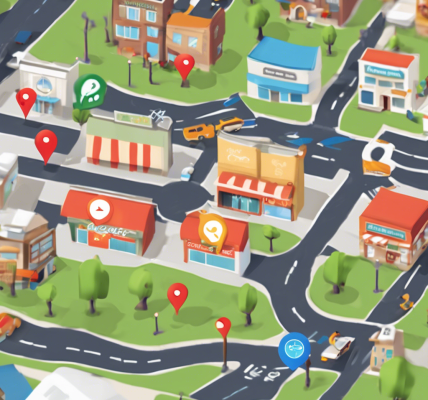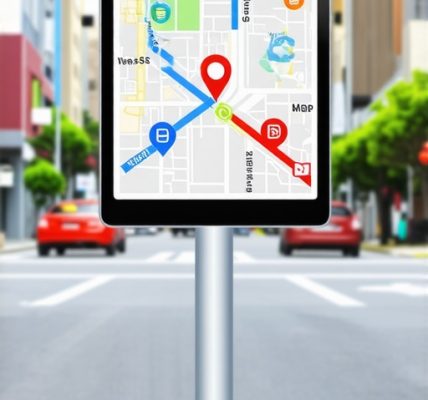Understanding the Importance of Google Maps for Local Businesses
In today’s digital landscape, optimizing your Google Maps listing is crucial for driving local growth. With billions of searches conducted on Google each day, having a well-optimized listing can significantly enhance your visibility and attract more customers to your business. But what exactly does it mean to optimize a Google Maps listing, and why is it important?
Key Elements of a Google Maps Listing
Your Google Maps listing is essentially your business’s online identity. It includes essential information such as your business name, address, phone number, and website. However, optimizing your listing goes beyond just filling out these details. Here are some key elements to focus on:
1. Accurate Business Information
Ensure that your business name, address, and phone number (often referred to as NAP) are accurate and consistent across all platforms. Inconsistencies can confuse potential customers and harm your local SEO efforts. For more tips on maintaining accurate information, check out this helpful guide.
2. Categories and Attributes
Selecting the correct categories for your business helps Google understand what services you offer. Choose primary and secondary categories that best describe your business. Additionally, utilize attributes to highlight specific features, such as “wheelchair accessible” or “free Wi-Fi.” This not only improves your visibility but also caters to customer preferences.
3. Engaging Business Description
Your business description is an opportunity to tell potential customers what makes you unique. Use relevant keywords naturally to improve your searchability while keeping the tone engaging and informative. For more on crafting effective descriptions, refer to this article.
Visual Content: The Power of Images
Including high-quality images in your Google Maps listing can significantly boost engagement. Photos of your products, services, or even your team can help potential customers connect with your business on a personal level. Regularly update your images to keep your listing fresh and appealing.
Tips for Photo Optimization
When uploading images, consider the following:
- Use High-Quality Photos: Ensure that your images are clear, well-lit, and represent your business accurately.
- Rename Image Files: Use descriptive file names that include relevant keywords before uploading.
- Geotag Images: Including location data in your images can help improve local search rankings.
Encouraging Customer Reviews
Customer reviews play a significant role in local SEO and can influence potential customers’ decisions. Encourage satisfied customers to leave positive reviews on your Google Maps listing. Responding to reviews, both positive and negative, shows that you value customer feedback and enhances your business’s credibility. For best practices on generating reviews, check out this resource.
Monitor Your Reviews
Regularly monitor your reviews to gauge customer sentiment and address any concerns promptly. This proactive approach can help maintain a positive reputation and improve your local search performance.
Utilizing Google Posts for Engagement
Google Posts are a powerful yet often overlooked feature of your Google Maps listing. By sharing updates, promotions, or events directly on your profile, you can enhance customer engagement and encourage more interactions with your business. Regularly posting relevant content not only keeps your audience informed but also signals to Google that your business is active, potentially improving your local search rankings.
Best Practices for Google Posts
Here are some effective strategies to leverage Google Posts:
- Consistency is Key: Aim to post regularly, whether weekly or bi-weekly, to maintain visibility and engagement.
- Include a Call to Action: Encourage users to take specific actions, such as “Call Now,” “Learn More,” or “Book an Appointment.” This can significantly increase engagement.
- Use Eye-Catching Images: Just like your listing, the visual aspect of your posts matters. High-quality images can draw attention and lead to higher interaction rates.
Keyword Optimization in Your Listing
Incorporating relevant keywords into your Google Maps listing helps improve your visibility during searches. These keywords should reflect the services you provide and the terms potential customers are likely to use when searching for businesses like yours.
Researching Effective Keywords
Tools like Google Keyword Planner can help identify keywords with high search volumes related to your industry. Once you have a list of target keywords, integrate them naturally into your business description, services, and posts. For more insights on keyword strategies, check out this guide.
Leveraging Local SEO Techniques
Improving your local SEO is crucial for maximizing the effectiveness of your Google Maps listing. Local SEO focuses on optimizing your online presence to attract more business from relevant local searches.
Essential Local SEO Strategies
Here are a few strategies to enhance your local SEO:
- Build Local Citations: Ensure your business is listed in local directories and citation sites, maintaining consistent NAP information across platforms. Explore citation management tips for better results.
- Engage with the Community: Participate in local events or sponsor community activities. This not only builds your brand’s reputation but also helps in gaining local backlinks.
- Optimize for Mobile: More consumers are searching for local businesses on mobile devices. Ensure your website is mobile-friendly to improve user experience and engagement.
Analyzing Performance Metrics
Monitoring the performance of your Google Maps listing is essential for understanding the effectiveness of your optimization efforts. Google My Business provides insights into how customers find your listing and how they interact with it.
Key Metrics to Track
Focus on metrics such as:
- Search Queries: Understand which search terms lead users to your listing.
- Customer Actions: Track how many users visit your website, request directions, or call your business.
- Photo Views: Analyze how many times your photos have been viewed, as this can indicate user interest.
Regularly reviewing these metrics can guide your future optimization strategies and help you identify areas for improvement. For a comprehensive audit of your performance, see this detailed guide.
Staying Ahead with Google Business Insights
Utilizing Google Business Insights is key to understanding how your customers interact with your Google Maps listing. These insights provide valuable data on how customers find your business, what actions they take, and how you can further optimize your presence. By analyzing this data, you can identify which strategies are working and where adjustments are needed.
Understanding Customer Interaction Metrics
Focus on metrics such as:
- Impressions: Know how often your business appears in search results, which can indicate your visibility.
- Click-Through Rates (CTR): Measure how many people click on your listing compared to how many see it, helping gauge effectiveness.
- Engagement Actions: Track actions like calls, website visits, and direction requests to assess user interest.
For more detailed strategies on analyzing these metrics, refer to this guide.
Enhancing Local Engagement Through Community Involvement
Engaging with your local community is a powerful tactic for improving your Google Maps ranking. Businesses that actively participate in community events or sponsor local activities often enjoy increased visibility and traffic. This not only boosts your brand reputation but also helps in building local backlinks, which are beneficial for SEO.
Building Relationships with Local Organizations
Consider collaborating with local organizations or charities. Such partnerships can lead to mutual promotions and a stronger community presence. For instance, sponsoring a local sports team or hosting community workshops can enhance your business profile and generate positive local buzz.
Utilizing Google My Business Features for Better Visibility
Google My Business offers a range of features that can enhance your listing’s visibility. Take advantage of features like Q&A, where customers can ask questions directly on your listing, and you can respond promptly. This not only builds trust but also allows you to showcase your expertise.
Leveraging Appointment Booking and Messaging
Implementing appointment booking and messaging capabilities through your Google My Business profile can streamline customer interactions. These features enable potential customers to reach out directly for inquiries or to schedule services, making it easier for them to engage with your business. For more on these features, check out this resource.
The Role of Social Media in Local SEO
Social media is another avenue that can complement your Google Maps SEO efforts. Sharing your Google Maps listing on social platforms can drive additional traffic and engagement. Regularly posting updates about your business, promotions, or community involvement can keep your audience engaged and informed.
Creating Shareable Content
Content that encourages sharing, such as promotions or community events, can enhance your online presence. Utilize visuals and engaging narratives to draw attention to your posts while driving traffic back to your Google Maps listing. To explore effective content strategies, visit this article.
Continuous Learning and Adaptation
The digital landscape is constantly evolving, and staying updated with the latest trends in local SEO is vital. Engage in ongoing learning through webinars, online courses, and industry news to keep your strategies fresh and effective.
Joining Local SEO Forums and Groups
Participating in local SEO forums or groups can provide insights and tips from other professionals in your field. Sharing experiences and strategies can spark new ideas and approaches that enhance your own Google Maps listing optimization efforts. For a comprehensive overview of local SEO, consider exploring this guide.
Exploring Advanced Google Maps Optimization Strategies
To truly maximize your Google Maps listing, delving into advanced optimization techniques is necessary. These strategies not only enhance visibility but also improve customer engagement and ultimately drive conversions. Here, we will explore effective methods to elevate your local SEO efforts.
Utilizing Google My Business Insights for Strategic Decisions
One of the most beneficial features of Google My Business (GMB) is the insights it provides. By analyzing customer interactions, you can refine your marketing strategies. Pay attention to metrics such as:
- Search Queries: Identify the search terms that lead customers to your listing.
- Customer Actions: Monitor how users are interacting with your listing—whether they are requesting directions, calling, or visiting your website.
- Time of Engagement: Understanding when customers interact with your listing can help you optimize your posting schedule.
Implementing Local Backlink Strategies
Building local backlinks is essential for enhancing your Google Maps ranking. Collaborate with local bloggers, newspapers, or community websites to gain backlinks that direct traffic to your listing. It establishes credibility and enhances your local presence. For further insights on backlink strategies, check out this resource.
Engagement Through Google Q&A and Messaging
Engaging with customers through the Q&A feature on your Google Maps listing can boost interaction and trust. Here’s how to effectively utilize this feature:
- Respond Promptly: Quick responses to customer inquiries show that you value their time and questions.
- Provide Comprehensive Answers: Offer detailed answers to common questions about your business or services.
Additionally, enable messaging features to allow potential customers to reach out directly. This can lead to higher engagement and conversions. For a deeper dive into engagement tactics, visit this guide.
Incorporating User-Generated Content
User-generated content, such as customer photos and testimonials, can enhance your Google Maps listing. Encourage satisfied customers to share their experiences and tag your business. This not only serves as social proof but also enriches your listing’s visual appeal.
Leveraging Seasonal Promotions and Events
Seasonal promotions can significantly increase traffic to your Google Maps listing. Use Google Posts to advertise special offers during holidays, events, or community gatherings. This strategy keeps your listing fresh and encourages user engagement. For tips on effective promotions, explore this article.
Creating a Content Calendar
Having a content calendar for your Google Posts can streamline your marketing efforts. Plan posts around relevant local events, holidays, or seasons. This ensures a consistent flow of content that keeps your audience engaged and informed.
Monitoring Competitors for Insights
Keeping an eye on your competitors can provide valuable insights into what strategies are working in your area. Analyze their Google Maps listings, customer reviews, and engagement tactics to identify areas where you can improve or differentiate your business.
Continuous Learning and Adaptation
The landscape of local SEO is ever-changing. Stay abreast of the latest trends and updates in Google My Business features to ensure your strategies remain effective. Attend webinars and follow industry blogs to adapt your approach as needed.
By implementing these advanced strategies, you can ensure that your Google Maps listing stands out in the competitive local landscape. For a comprehensive guide to mastering Google Maps SEO, visit this resource.
Frequently Asked Questions (FAQ) About Google Maps Optimization
1. How can I improve my Google Maps ranking?
Improving your Google Maps ranking involves optimizing your Google My Business listing with accurate information, engaging visuals, and positive customer reviews. Additionally, implementing local SEO strategies, participating in community events, and utilizing Google Posts can enhance your visibility.
2. What are local citations and why are they important?
Local citations are mentions of your business’s name, address, and phone number (NAP) on various online platforms. They are essential for local SEO as they help establish credibility and improve your rankings in local search results.
3. How do customer reviews affect my business?
Customer reviews significantly influence potential customers’ decisions and your local SEO. Positive reviews can enhance your reputation, improve your visibility on Google Maps, and encourage more customers to choose your business.
4. What role do photos play in my Google Maps listing?
High-quality photos can greatly enhance your Google Maps listing by attracting potential customers and increasing engagement. They help create a positive first impression and showcase your offerings effectively.
5. How often should I update my Google Maps listing?
Regular updates to your Google Maps listing are crucial. Aim to post updates, promotions, and fresh content at least once a week to keep your listing relevant and engaging to potential customers.
6. What are Google Posts and how can they benefit my business?
Google Posts allow businesses to share updates, events, and promotions directly on their Google Maps listing. Utilizing this feature can enhance customer engagement, drive traffic, and improve your local SEO performance.
7. Can I optimize my Google Maps listing for mobile users?
Yes, optimizing your listing for mobile users is essential as many local searches are conducted on mobile devices. Ensure your website is mobile-friendly and create concise, engaging content for your Google Maps listing.
8. How do I track the performance of my Google Maps listing?
You can track your Google Maps listing’s performance using Google My Business insights. Key metrics to monitor include search queries, customer actions, and photo views, which can help guide your optimization strategies.
9. What should I include in my business description for Google Maps?
Your business description should be engaging and informative, highlighting your unique offerings and including relevant keywords that potential customers might use when searching for services like yours.
10. How can I encourage more customer reviews?
Encouraging satisfied customers to leave reviews can be achieved by simply asking them after a positive interaction. You can also follow up with a thank-you email that includes a direct link to your Google Maps listing for easy access.
Authority Resources for Google Maps Optimization
For further reading and expert insights on optimizing your Google Maps listing, consider the following trusted resources:
- Google My Business Help Center – Official support for managing your Google My Business account.
- Moz’s Ultimate Guide to Local SEO – Comprehensive resource on local SEO strategies.
- Neil Patel’s Guide to Local SEO – Insights from a leading digital marketing expert.
- Search Engine Journal’s Local SEO Guide – In-depth overview of local SEO best practices.
- BrightLocal’s Local SEO Learning Hub – A wealth of resources and articles on local SEO.
Conclusion
In conclusion, optimizing your Google Maps listing is a multifaceted approach that requires consistent effort and strategic planning. By implementing the strategies discussed, including enhancing your listing with accurate information, engaging visuals, and customer interaction, you can significantly improve your local SEO performance. Remember, a well-optimized Google Maps listing not only increases your visibility but also helps in attracting more customers to your business, making it an essential component of your overall marketing strategy.


